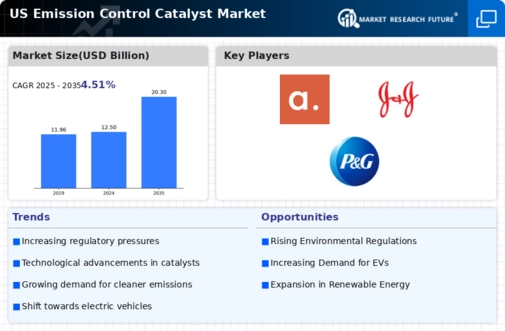The emission control catalyst market is characterized by a dynamic competitive landscape, driven by stringent environmental regulations and the increasing demand for cleaner automotive technologies. Key players such as BASF (US), Johnson Matthey (GB), and Umicore (BE) are strategically positioned to leverage innovation and sustainability in their operations. BASF (US) focuses on developing advanced catalyst technologies that enhance vehicle efficiency, while Johnson Matthey (GB) emphasizes its commitment to sustainability through the development of low-emission solutions. Umicore (BE) has adopted a strategy centered on recycling and resource efficiency, which aligns with the growing emphasis on circular economy principles. Collectively, these strategies not only enhance their competitive edge but also contribute to shaping a market increasingly oriented towards environmental responsibility.
In terms of business tactics, companies are localizing manufacturing to reduce lead times and optimize supply chains. The market structure appears moderately fragmented, with several players vying for market share, yet dominated by a few key firms that exert considerable influence. This competitive structure fosters innovation as companies strive to differentiate their offerings in a crowded marketplace.
In November 2025, BASF (US) announced a partnership with a leading automotive manufacturer to develop next-generation catalysts aimed at reducing NOx emissions by 30%. This collaboration underscores BASF's commitment to innovation and positions it favorably in a market that increasingly prioritizes stringent emission standards. The strategic importance of this partnership lies in its potential to enhance BASF's product portfolio while addressing regulatory pressures.
In October 2025, Johnson Matthey (GB) unveiled a new line of catalysts designed specifically for electric vehicles (EVs), which are projected to dominate the automotive market in the coming years. This strategic move reflects Johnson Matthey's proactive approach to evolving market demands and its intent to capture a share of the burgeoning EV segment. By aligning its product development with the shift towards electrification, the company is likely to strengthen its market position.
In September 2025, Umicore (BE) expanded its recycling capabilities by acquiring a state-of-the-art facility in the US, aimed at enhancing its resource recovery processes. This acquisition is strategically significant as it not only bolsters Umicore's sustainability credentials but also positions the company to meet the increasing demand for recycled materials in catalyst production. The move aligns with global trends towards resource efficiency and circular economy practices.
As of December 2025, the competitive trends in the emission control catalyst market are increasingly defined by digitalization, sustainability, and the integration of AI technologies. Strategic alliances are becoming more prevalent, as companies recognize the need to collaborate to enhance innovation and operational efficiency. Looking ahead, competitive differentiation is likely to evolve from traditional price-based competition to a focus on technological advancements, sustainability initiatives, and supply chain reliability. This shift indicates a market poised for transformation, where innovation and environmental stewardship will be paramount.














Leave a Comment